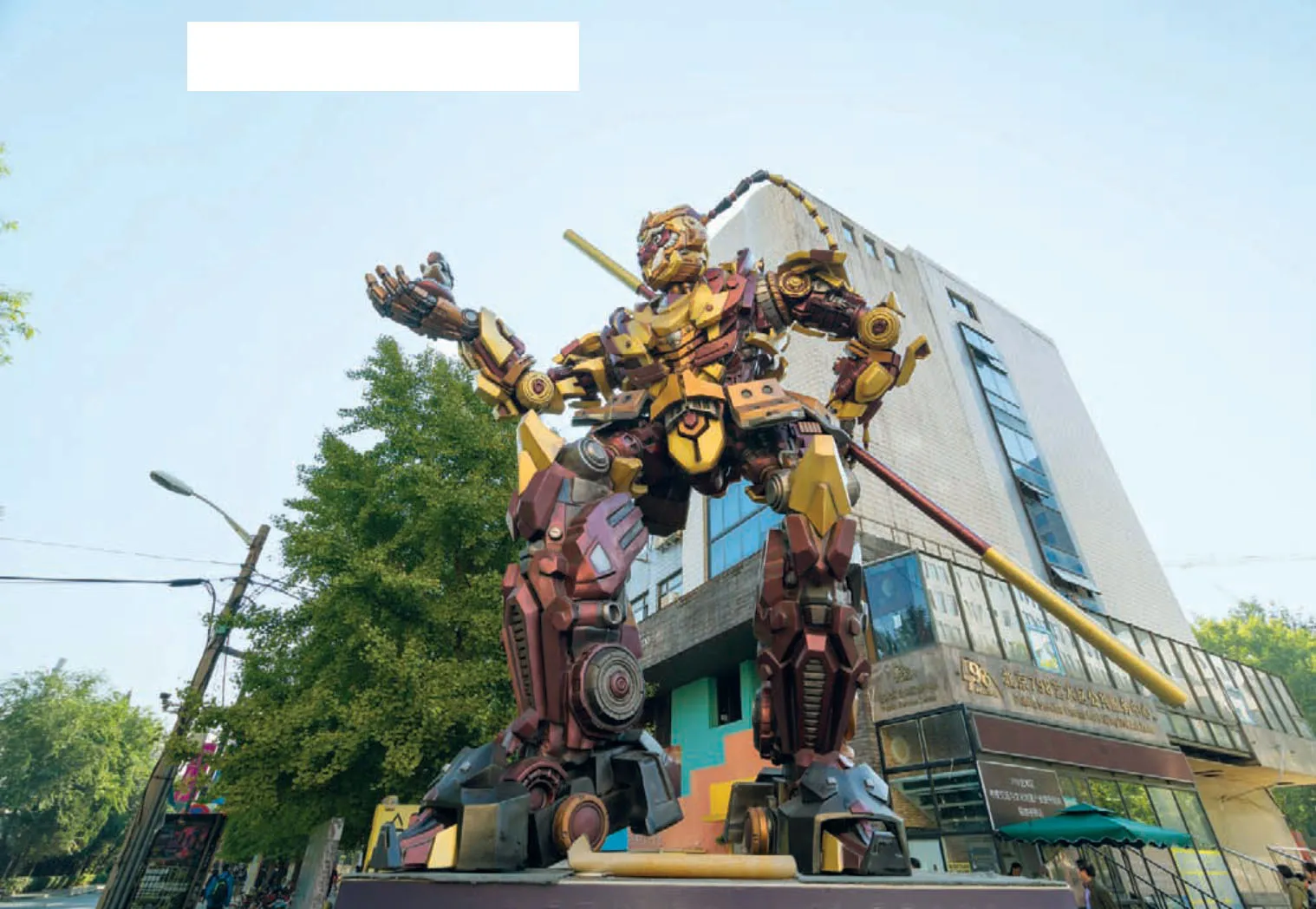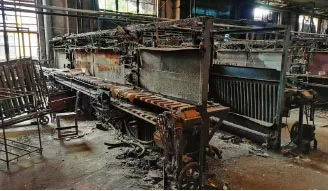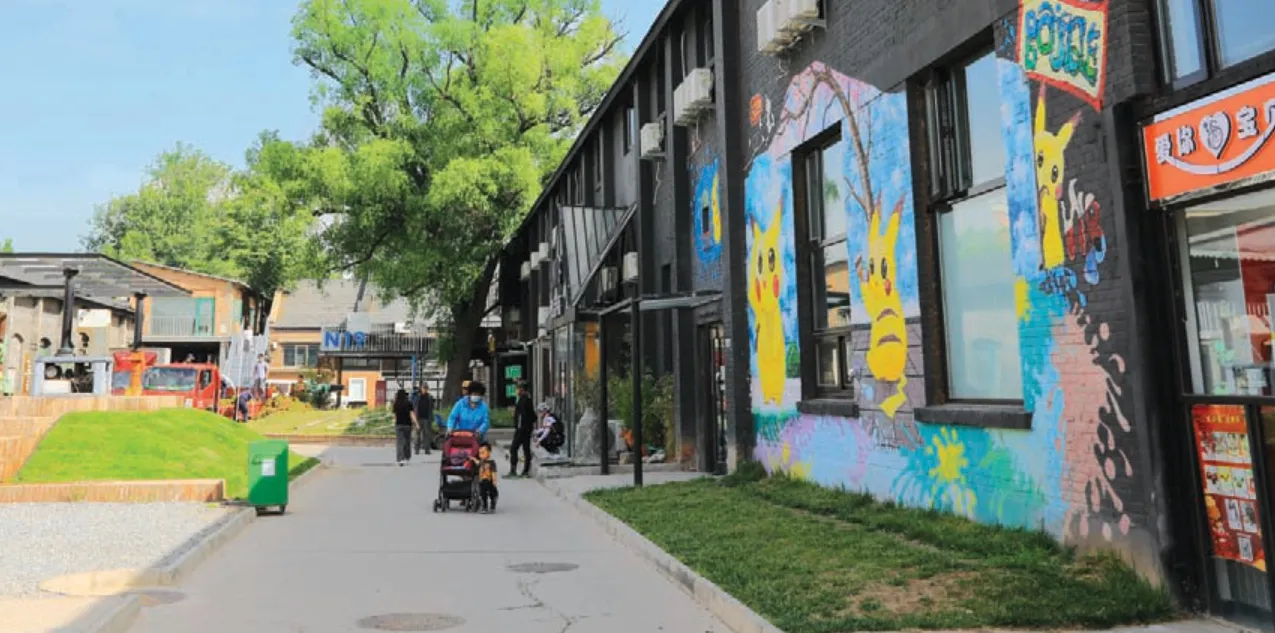INDUSTRIAL EVOLUTION
2022-10-15

TEXT BY YANG TINGTING (杨婷婷)ILLUSTRATION BY CAI TAO PHOTOGRAPHS FROM WEN NING AND VCG
Can heritage protection projects give new life to China’s abandoned factories?
老工业遗址改造,能否重现曾经的辉煌?
When tourists ask for directions from Wu Zhen,a handyman in a shopping plaza inside Beijing’s Shougang Industrial Park,they might get a trip down memory lane.“That was the warehouse with the furnaces where we used to burn steel under thousands of degrees of heat,” he says when TWOC visits one Friday in August,pointing to a rusty metal building.“That’s a tower for storing water…the red brick building is the May Day Theater where we used to watch movies and performances,and have staff meetings.”
Wu,now 49,has worked in this suburban compound outside Beijing’s Fifth Ring Road since 1992,but he wasn’t always a handyman.He first joined as an apprentice “steel roller,”responsible for making sure the steel bars did not get stuck when coming out of the rolling machine,back when the Shougang (“Capital Steel”)complex was still a mill.Built in 1919,the Shougang mill produced as much as 10 million tons of iron and steel and employed 60,000 workers in its heyday.
In 2008,the Beijing government announced it was closing the mill due to air pollution,and many of Wu’s colleagues moved to a new factory on the coast of Hebei province.Others accepted benefit packages to retire early,and over 2,000 employees,including Wu,were offered new positions as security staff,waiters,plumbers,and electricians in the industrial park,which opened to the public in 2020.
Cafes,bookstores,hotels,and offices now inhabit Shougang’s warehouses and blast furnaces.Self-driving cars putter around the massive compound for testing,and during the 2022 Winter Games,Olympic athletes famously launched themselves down the Big Air Ramp,which was built against the striking backdrop of Shougang’s former cooling towers.
Today,China is home to 194 national-level “industrial heritage”sites,most of them decommissioned factories,rail yards,and even slaughterhouses whose rise and fall mirrors the history of heavy industry in many Chinese cities.China began to de-industrialize in the 1990s,closing down factories or moving them outside major urban centers.This left industrial relics—often massive state-owned production and living compounds spanning entire neighborhoods,with their own schools,hospitals,and apartment complexes—that cities either need to demolish or renovate and repurpose.
Seeing opportunities in old factories for their large space and low rental costs,investors have turned many industrial relics into parks,museums,art galleries,startup incubators,and hip “art districts” to generate new value for the surrounding community.China’s sports authorities have also encouraged businesses to convertindustrial buildings,such as Shougang,into sports facilities to provide more exercise space in crowded cities,provided they meet certain redesign,rental,and fire safety standards.

After the Beijing 2022 Winter Olympics ,Shougang’s sports facilities opened to the public to use
The concept of protecting industrial heritage is widely believed to have started with the demolition of the old Euston railway station in London,built in 1837 but completely rebuilt in the 1960s.Its grand Doric archway was removed in the process,sparking a national outcry and a movement to conserve Britain’s Victorian industrial sites.
In China,Shanghai was one of the first cities to make an effort to protect its former industrial sites.In 1989,the city government listed 59 industrial buildings,such as the Yangshupu Waterworks (built in 1913 by British businessmen),as historic sites for better use and protection,turning them into parks,museums,office spaces,and exhibition halls.
The first industrial heritage protection meeting in the country was held in Wuxi,Jiangsu province,in 2006,the same year the National Cultural Heritage Administration issued a “Notice on Enhancing Protection of Industrial Heritage,”which officially marked the beginning of industrial heritage research and protection in China.Since 2017,the central government has released six lists of national industrial heritage sites including plants,workshops,mills,and warehouses built before 1980 as sites that local cultural bureaus are required to protect.In the process,they have raised public awareness of the country’s industrial heritage and transformed the urban landscape.

Renewal projects generally try to maintain the industrial look and features of the site
Located in Chaoyang district in Beijing,the 798 Art District is one of the most iconic and successful examples of a protected industrial site.Formerly housing the state-owned 718 electronics factory,built in 1952 with Soviet assistance,the 798 district was gradually abandoned in the 1980s and 90s as production slowed down.At the turn of the century,artists attracted by the spacious and unique Bauhaus-style workshops began renting them from the factory at bargain basement prices,converting them into loft apartments and studios.
In 2006,Beijing’s municipal government and Chaoyang district government jointly invested over 120 million yuan to transform the factory complex into a “cultural and creative industrial base.” This meant improving fire safety and road conditions,upgrading the plumbing,and installing indoor heating and street lamps.The process was not without opposition: Artists in the district complained that the renovations disrupted their work and removed many historic features of the buildings,while also making the area too expensive for them to stay in.
The art zone now hosts about 200 galleries,exhibitions,art centers,and independent artists,along with fashionable boutiques,cafes,and restaurants catering to the increasingly upscale visitors to the area.According to Hunan province’s Xiaoxiang Chenbao newspaper,over 90,000 people visited 798 during the threeday Qingming Festival long weekend in April this year,generating about 58 million yuan in revenue.
The success of the 798 Art District has meant that art districts and creative parks have become some of the most popular options for governments and urban developers looking for an easy way to repurpose their industrial bases for quick returns.Visit most major cities in China,and chances are you’ll find a red-bricked compound with cafes or culture industry startups operating out of former silos and furnaces,often with contemporary art out front.A 2020 report by China Newsweekly magazine estimates there are around 40,000 creative industrial parks in China,with 400 in Beijing alone.
Liu Xiaoqiang wasn’t optimistic when she took over an antique store her friend operated in 798 and turned it into a shop selling shaved ice in 2019,at a monthly rental cost of about 20,000 yuan.She found,however,that art exhibitions guaranteed a steady trickle of customers to the district—last winter’s“Comic Bananas” exhibition by Maurizio Cattelan brought her over 200 customers per day.
Operating inside old factories,however,comes with issues from the timeworn infrastructures.Liu complains of problems with drainage,leakage,waterproofing,and power failure.“Each time when it rains,our ceilings will leak.Sometimes when it rains heavily,the whole district gets flooded,” she says,recalling that flooding trapped her staff inside the store for two hours last summer.“The drainage system and the angle of the pavements here are not designed well.”
Chongqing-based community planner He Shuaishuai believes that,instead of catering to tourists and non-local business owners,conversion projects should benefit the local residents in formerly industrial neighborhoods,who tend to be retired workers who used to depend on the state-owned industrial group for public services and community life.Dr.He has a PhD in heritage conservation and urban revitalization from the University of Oxford,and has worked since 2020 in the Zhongxinwan community in Chongqing’s Shapingba district,formerly the residential quarters of the renowned Special Steel Factory before it went bankrupt in 2005.
“Back when they worked in the factory,the residents had a stadium,a theater,and lots of places for social activities and exercise;now they can no longer use these facilities and don’t have many other public spaces,” Dr.He tells TWOC.
She explains that without adequate planning,industrial culture parks can increase the cost of living for locals,and points out that former industrial neighborhoods tend to be “negative urban spaces” facing issues like unemployment,tired urban amenities,and an aging population,none of which can be addressed by simply bringing in tourists.“Some residents…feel they’ve been leftbehind by society after all their contributions to the country,” she says.

Many visit the 798 District not for the art exhibitions,but to explore the industrial ruins
When Chen Changjiang from Yili,Xinjiang,turned the 3,000-square-meter timber mill owned by his uncle into a gym in 2019,a decade after the mill had to suspend operation due to pollution concerns,he hoped it would bring positive changes to the local community.After two months of construction at a cost of 1.5 million yuan,Yili’s first private gym quickly attracted about 500 local students,who could play basketball,football,or other sports for the whole day.
The mill’s closure had triggered the surrounding neighborhood to decay,with only retired workers remaining in the aged apartments and streetlights no longer maintained.But since the gym opened,“more people have come to start businesses,like barbecue restaurants,bars,and shops,” says Chen.“People started to notice the place and how it brought a lively atmosphere to the old community.Companies also come to us to hold gatherings and sports activities.”
These benefits,though,did not come cheap to Chen.Pitching his project to the local government as a “green initiative,” the 37-year-old first had to clear out timber scraps left buried for years underground,which took over 70 trucks to remove to a landfill.Heating the massive and poorly insulated buildings is also a crippling expense—Chen estimates it costs him tens of thousands of yuan per month in winter.He had started looking for a solution,but after hearing rumors that the government may demolish the factory in the future,he gave up,and plans to simply continue paying the costs until he gets shut down.

A sculpture made of abandoned machinery parts in 798

Old furniture and machinery become art exhibitions themselves when displayed in the open at 798
Many projects for converting industrial heritage struggle to turn a profit.An unnamed research firm in Guangzhou cited in China Newsweekly estimated that 80 percent of China’s creative industrial parks are operating at a loss.Without any specialized industry supporting their existence,they depend on renting out facilities to shops that operate there,as well as government assistance—according to the same report,government subsidies allow industrial parks to slash their rental fees by 50 percent of the market rate.But even this may not be enough to attract long-term tenants,as the report states the vacancy rate in industrial parks in smaller cities can be as high as 50 percent.
Unsuccessful industrial parks suffer from issues of homogenization.There are those who,while calling themselves “creative” incubators,allow businesses in other fields to register,such as consulting firms and health supplement brands.
Others have not distinguished themselves by appearance or character,offering similar-looking brick walls and Yue Minjun-inspired art installations in a poor imitation of 798.“A lot of parks didn’t dig out the story behind the place to distinguish it from others,” Liu Furong,a Chongqing-based designer for GABO Gallery,a sanitaryware brand based in an old porcelain factory in Foshan,Guangdong province,tells TWOC.He calls these places “just a shopping street under the name of‘cultural and creative park,’” without anything cultural or creative and only good for social media “check-ins.”
As a solution,Liu’s GABO Gallery preserves the timeworn porcelain flowerpot,wooden beams,and red bricks and coils of its historic space as a backdrop to its modern furniture.“The most important thing is to give new life to old factories.If we just wipe out all the marks of age,we might as well raze it,” he says.“It’s a pity that some city renewal projects change the color of old buildings,whose texture comes naturally and cannot be bought by money.”
Dr.He,on the other hand,believes appealing only to consumers makes a heritage project bound to fail.“How many locals will go to art exhibitions or see pop-up shows all the time?It’s not realistic,” she tells TWOC.Currently,the state-owned Chongqing Xuchen Group is planning to invest about 3.2 billion yuan in turning the Special Steel Factory into an industrial park,which Dr.He hopes will become a fully open space for the local residents with facilities for elderly care,childcare,and other services.
She believes this will create jobs,and provide community services these worn-out neighborhoods urgently need.“If we just build an industrial park,wall it off,and invite some cultural industries to set up here,it will be cold and cheerless,” she says.
Industrial parks that fail,or are left to rot due to having never been converted,are not without their own charm for urban adventurers.Wen Ning,a Beijing-based entrepreneur in his thirties,fell in love with historic buildings while living in Germany in his 20s,and now likes to explore industrial ruins across China—including abandoned factories,chemical plants,and mine pits.
This July,Wen explored an abandoned thermos bottle factory in Beijing.Standing beside the broken windows of an office on the second floor,he could imagine the bustling scenes of 50 years ago when hundreds of workers thronged the assembly line to put bottles together,accompanied by the cacophony of the machines.“That energy was the energy of the generation of people who tried to build a socialist China.It makes you emotional.You believe in the passion of that era,even if [the building] is in ruins now,” he says,calling abandoned factories “natural museums” of history.
INDUSTRIAL PARKS THAT ARE LEFT TO ROT ARE NOT WITHOUT CHARM FOR URBAN ADVENTURERS.
But without any protection,these natural museums may disappearcompletely.In July,Wen visited a steam locomotive warehouse in Beijing he’d explored twice before,only to find the roof had collapsed after heavy rain and crushed the engine inside.

An unrestored thermos-bottle factory Wen Ning explored in the Beijing outskirts preserves the look of industrial decay

Urban planners call for converted industrial parks to preserve spaces for locals as well as businesses and tourists
Wu,the steel worker-turnedhandyman at Shougang,still misses the era when the factory was his entire world.“At that time,we didn’t want to go home at the end of the day.We could play cards and basketball,chat,take baths,and even cook in our factory dormitory.Now I don’t want to stay a minute longer after I clock offwork,” he says.“Sometimes,I get lost among these new buildings and have to use a navigation app to get around.”
